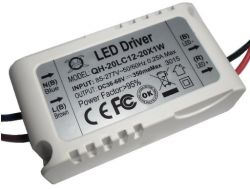FAQ
TL;DR: 1000 mA = 1 A, and “1V * 1A = 1W.” Use P = U × I: 36 V × 1.4 A and 72 V × 0.7 A both equal 50.4 W; with 90% efficiency, input must be higher. [Elektroda, MACIEK_M, post #18012897]
Why it matters: This FAQ helps DIYers and pros convert V/A to W correctly and pick safe, efficient LED drivers for home lighting.
Quick Facts
- Power equals voltage times current (P = U × I). “1V × 1A = 1W.” [Elektroda, MACIEK_M, post #18012897]
- 36 V × 1.4 A and 72 V × 0.7 A represent identical power: 50.4 W each. [Elektroda, MACIEK_M, post #18012897]
- Input power exceeds output; the difference is heat. Example: 56 W in, 5.6 W lost, ≈90% efficient. [Elektroda, kblg13, post #18013133]
- High‑power LEDs need constant‑current drivers; match driver current (If) and ensure driver voltage covers LED Vf. [Elektroda, krzysiek_krm, post #18021889]
- Constant‑voltage supplies can trip protection if current is exceeded; LED drivers specify voltage range and regulated current. [Elektroda, kj1, post #18022259]
How many watts is 36 V at 1400 mA and 72 V at 700 mA?
Use P = U × I. Convert 1400 mA to 1.4 A and 700 mA to 0.7 A. 36 V × 1.4 A = 50.4 W. 72 V × 0.7 A = 50.4 W. Both cases have equal wattage. [Elektroda, MACIEK_M, post #18012897]
What formula converts volts and amps (or mA) to watts?
Power equals voltage times current: P = U × I. Convert milliamps to amps by dividing by 1000. Example: 12 V × 0.5 A = 6 W. “1V * 1A = 1W.” [Elektroda, MACIEK_M, post #18012897]
Someone told me both cases are 56 W. When can that be correct?
That can describe input power when efficiency is considered. If output is 50.4 W and efficiency is 90%, input is about 56 W. The 5.6 W difference is heat lost in the supply. Use Pin = Pout / η for this conversion. [Elektroda, kacpo1, post #18013476]
How do I compute input, output, and losses for a power supply?
Use efficiency η. Output equals input times η. Loss equals input times (1 − η). Example: 56 W input at 90% efficiency loses 5.6 W and delivers about 50.4 W. Those losses heat the power supply, not the load. [Elektroda, kacpo1, post #18013476]
How can I tell the input was 56 W or the loss was 5.6 W?
Check the rating plate for input consumption. If efficiency is listed, compute losses from it. With 56 W input and 90% efficiency, loss is 56 × 10% = 5.6 W. Output equals 56 W minus 5.6 W. [Elektroda, kacpo1, post #18013476]
Which is better for a 70 W LED if I only want about 50 W?
Pick by LED current and voltage, not by V vs A tradeoff. Choose a constant‑current LED driver matching the LED’s If. Ensure the driver’s voltage range covers the LED’s Vf. Use a dimmable driver to set power near 50 W. [Elektroda, krzysiek_krm, post #18022249]
Why is “36 V and 1400 mA vs 72 V and 700 mA” the wrong question for LEDs?
LEDs are current‑driven devices. “This is a wrong question.” Use a constant‑current driver that matches the LED current. Ensure the driver’s voltage range covers the LED’s forward‑voltage range. Efficiency depends on driver design, not V vs A alone. [Elektroda, krzysiek_krm, post #18021889]
Can I dim a high‑power LED with a potentiometer?
Avoid a series potentiometer at tens of watts. It wastes power and can overheat. Use a dimmable constant‑current driver or PWM control. “With this LED power, the potentiometer is off.” [Elektroda, kacpo1, post #18022005]
What happens if I power LEDs from a constant‑voltage supply?
A constant‑voltage supply regulates voltage and has a current limit. If your LED string exceeds that current, protection may trip and disconnect output. Proper LED drivers regulate current and list an allowable voltage range. [Elektroda, kj1, post #18022259]
How do I pick a constant‑current LED driver? (How‑To)
- Check your LED’s forward current (If) and forward voltage (Vf).
- Select a constant‑current driver with output current equal to If.
- Ensure the driver’s voltage range spans Vf with headroom; pick dimmable if you need brightness control. [Elektroda, krzysiek_krm, post #18022249]
What’s the difference between input watts and output watts on a supply?
Input power is always higher than output. The difference becomes heat in the supply. Example discussed: 56 W in versus about 50–51 W out, near 90% efficiency. That waste heat must be managed for reliability. [Elektroda, kblg13, post #18013133]
How do I convert mA to A quickly before calculating watts?
Divide by 1000. For example, 700 mA = 0.7 A and 1400 mA = 1.4 A. Then use P = U × I to get watts. This yields 50.4 W for both example cases. [Elektroda, MACIEK_M, post #18012897]

